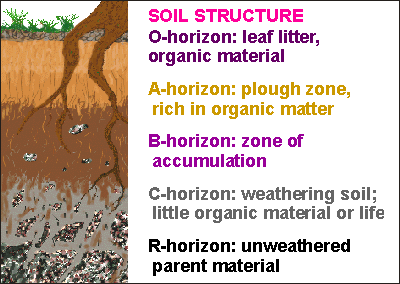| One of the most important scientific discoveries was how soil forms spontaneously from rock. Under the influence of physical factors like deformation by heat and cold, assault by wind, rain, hail and ice, and the enormous levering forces of water expanding into ice, solid rock is shattered into smaller pieces (see picture). But however small these fragments, they still have the same properties as the parent rock. Being formed under high pressure and temperatures, the crystals of the minerals in the rock are somewhat unstable at surface pressure and temperature. Particularly when attacked by acids that etch away the soluble components in the minerals, the crystals fall apart, albeit very slowly. It is called spontaneous weathering, but it is accelerated considerably under the influence of vegetation and its acids (chemical weathering). |
Depending on temperature and rainfall, new minerals are formed. The oxides of iron and alumina combine with silica to form clay. In temperate regions a three-layer clay is formed, which is weak, swells under moisture, and clogs. It is able to absorb large amounts of water but is rather heavy on plant roots, blocking the oxygen the soil organisms need. Because clay has a charged surface area, it is able to bind and retain minerals and nutrients (Cation Exchange Capacity). The valuable nutrition for plants won't leach away easily in three-layer clays.
Two-layer clays are formed in hot, humid tropical regions, producing arable but easily dried soils. These clays are not able to hold much water, or nutrients, but are still very much better than sand.
Soil's productivity is mainly due to the clays in the soils. Knowing that clay particles are very small (less than 2 microns), one can imagine that this component is easily eroded out of the soil. Its small size prevents it from sedimenting out rapidly in water, resulting in rivers, lakes and ocean water staying turbid for a long time after rains have ended.
The mix of sand, silt and clay is called a loam. In this diagram, the triangle represents all possible combinations of the three. Soil specialists use names for the various loams, as indicated in the diagram. A loam can be dried and pounded in the laboratory and passed through sieves to separate the mix by particle size. From the diagram, the official composition of 'loam' can be inferred - sand:silt:clay = 40:40:20. (Draw lines parallel to each side and read the left-hand values.)
Sand is very workable but won't hold water, or nutrients well. Loam is poor in nutrients, reasonably workable, but holds water well. Clay is difficult to work, compacts easily, but holds water and nutrients well, but is reluctant to release these to plants. As the diagram shows, the various loams derived from the three base components, have varying workability, water holding capacity and cation exchange capacity (CEC).
Soil profile Whereas soil is formed from the rock below, it is eroded away from the top. A cover of plant life slows down erosion, allowing the soil layer to build up, but there is more going on. Whereas soil is formed from the rock below, it is eroded away from the top. A cover of plant life slows down erosion, allowing the soil layer to build up, but there is more going on.Just above the base rock, is the C-horizon, containing the recently weathered and still weathering soil. It is rich in nutrients. The A-horizon is where most plant roots are found and all soil organisms. Its nutrients have been used by plants or leached downward, so it is relatively poor in nutrients, but rich in life. By comparison, the B-horizon is the zone where new material from below and nutrients from above accumulate. Sometimes an impermeable layer or pan is formed above it (podsol), denying plants to access this rejuvenating source of new nutrients. On the surface of the soil, often a thin layer is found, rich in leaf litter and other organic material.
source:
|



0 komentar:
Posting Komentar